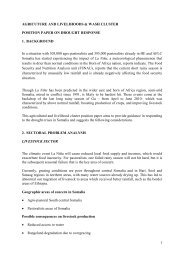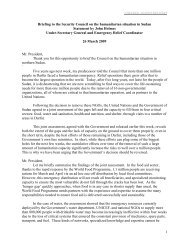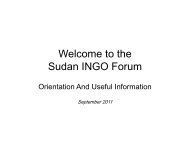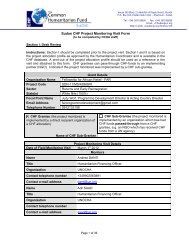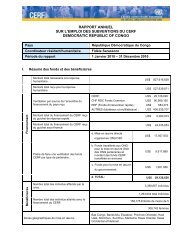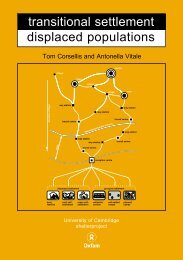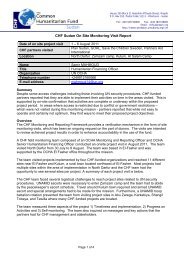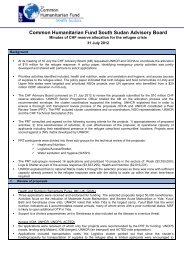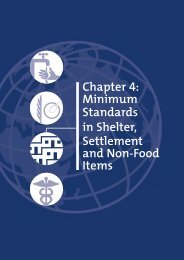Inter-Agency Real Time Evaluation of the Humanitarian ... - OCHANet
Inter-Agency Real Time Evaluation of the Humanitarian ... - OCHANet
Inter-Agency Real Time Evaluation of the Humanitarian ... - OCHANet
You also want an ePaper? Increase the reach of your titles
YUMPU automatically turns print PDFs into web optimized ePapers that Google loves.
IA RTE <strong>of</strong> <strong>the</strong> humanitarian response to Pakistan’s 2010 Floods crisis<br />
full list <strong>of</strong> people met, by organization, affiliation and <strong>the</strong> type <strong>of</strong> interview method<br />
used.<br />
� Group interviews held with over 686 people from <strong>the</strong> affected population including<br />
people still displaced in spontaneous camps and people that had returned to <strong>the</strong>ir land<br />
annex 3.1 outlines <strong>the</strong> list <strong>of</strong> camps and locations visited and <strong>the</strong> number <strong>of</strong> affectees<br />
interviewed at each.<br />
� Direct observation <strong>of</strong> coordination process both at district, provincial and federal level<br />
as well as <strong>the</strong> outcomes <strong>of</strong> relief and recovery responses.<br />
� Field visits to 20 different locations in three different provinces and <strong>the</strong> Federal Capital.<br />
The locations visited include two provincial capitals and 11 districts. An overview <strong>of</strong><br />
localities visited can be found in annex 4<br />
17. The evidence collected was used as basis to draw conclusions and recommendations. To<br />
<strong>the</strong> degree possible, <strong>the</strong> evaluators triangulated data and drew on multiple sources to ensure<br />
that findings could be generalised and were not <strong>the</strong> result <strong>of</strong> bias or views <strong>of</strong> a single agency or<br />
single type <strong>of</strong> actor involved in <strong>the</strong> response.<br />
Recommendation<br />
Figure 1: Triangulation. Information from interviews and <strong>the</strong> findings <strong>of</strong> <strong>the</strong> desk review were<br />
validated from <strong>the</strong> findings and cross‐validation.<br />
18. Adopting utilization focused approach in order to boost <strong>the</strong> ownership <strong>of</strong> <strong>the</strong> process,<br />
conclusions and recommendations were validated, prioritized and organizations responsible to<br />
implement <strong>the</strong>m and timelines were defined through three Provincial workshops and one<br />
national workshop (see annex 4). Following <strong>the</strong> workshops in Pakistan, headquarters debriefings<br />
were held with IASC representatives in Geneva and New York.<br />
19. <strong>Evaluation</strong> Constraints<br />
Conclusion A Conclusion B<br />
Finding 1 Finding 2 Finding 3 Finding 4 Finding 5<br />
Focus Group 1 <strong>Inter</strong>view 1 Data Analysis 1 Focus Group 2<br />
Observation 1<br />
Observation 2<br />
<strong>Inter</strong>view 2<br />
Document 1<br />
Observation 3<br />
Observation 4<br />
<strong>Inter</strong>view 3<br />
<strong>Inter</strong>view 4<br />
Issue 1 Issue 2 Issue 3<br />
Document 2<br />
<strong>Inter</strong>view 5<br />
<strong>Inter</strong>view 6<br />
� Timing <strong>of</strong> <strong>the</strong> evaluation; although this IA RTE was fielded at an earlier stage <strong>of</strong> <strong>the</strong><br />
humanitarian response to <strong>the</strong> epic floods disaster, as compared to <strong>the</strong> previous IA‐RTE<br />
Riccardo Polastro, Aatika Nagrah, Nicolai Steen and Farwa Zafar<br />
23




